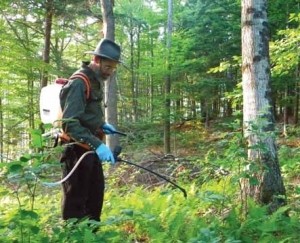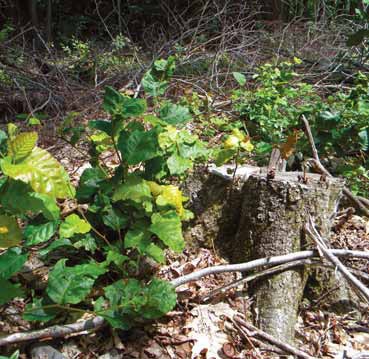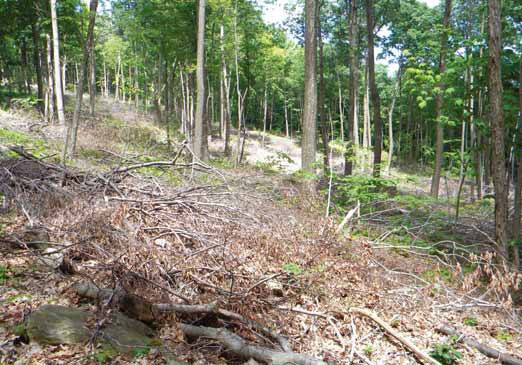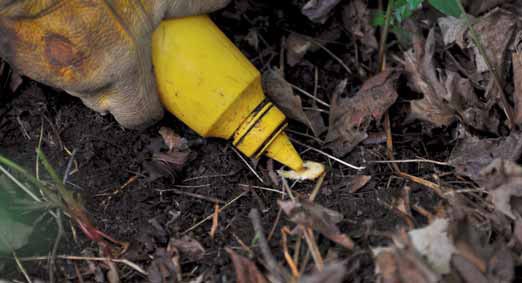Exotic invasive plants get the headlines, as they crowd out native species, deprive wildlife of food, and generally devalue the Northern Forest. But in certain cases, native plants can cause the same problems. In fact, on many of the woodlots I see, the native invasive plants are a much bigger problem than the exotic ones.
On my own woodlot, the native plants that have earned the invasive label are ferns (especially hay-scented), striped maple, and American beech. These plants are all indigenous, and they all have a habit of rapidly taking over large areas to the exclusion of other species.
The word “problem” is relative. Clearly, native invasive plants aren’t likely to take over the Northeast, or they would have already done so. Eventually – on the scale of decades or centuries – other species will almost undoubtedly grow on any given site.
Thus, the real problem with native invasive plants is that they conflict with our human desires. Simply put, we want to be growing different plants, whether for monetary, aesthetic, or wildlife reasons, and we want to be doing so now. In a world where property taxes and returns on investment play a role, many forest property owners want to grow valuable trees rather than native invasives. For landowners whose objective is to promote wildlife, having a woodlot that is dominated by plants that are poor food sources or habitat for their desired species will obviously not lead to success. (We should note that mature beech can be of considerable value to wildlife, because of the occasional crops of beechnuts, but many of the root sprouts die of beech bark disease before producing either nuts or merchantable wood.)
We’d likely feel very differently about ferns, striped maple, and beech taking over our woodlots if they produced valuable products. Imagine hay-scented fern or striped maple producing a valuable medicine, with the plants worth as much per pound as ginseng. Then we’d be looking to promote their growth! What if beech, whose prime sawlogs are currently worth little more than firewood, were as valuable as cherry or walnut?
Why So Prolific?
Native invasive plants come to dominate a woodlot in many ways. For starters, they’re usually shade-tolerant, and can grow, albeit slowly, in the low light levels found under forest canopies. Once established, they can form dense stands that shade out seedlings of other species. When the canopy is opened up, whether through logging, weather events, or death of overstory trees, the invasive plants in the understory are poised to grow quickly. Some use allelopathy, a form of chemical warfare, whereby the plant produces and disperses chemicals that inhibit the growth of neighboring plants.
People also share some blame for the success of native invasives. Sometimes only the more valuable trees are cut during a harvest, giving beech and striped maple a selective advantage.
Our wildlife policies have also had a profound influence on what plant species grow in our forests. Populations of deer and, to a lesser extent, moose have exploded in the last 100 years. Where populations are high, selective browsing affects the species of trees, shrubs, and herbaceous plants growing on the forest floor. Striped maple and beech are browse of last resort for deer, so seedlings of these trees have a huge advantage over seedlings of trees the deer prefer, such as ash, maple, and oak. My observations also suggest that wild turkeys influence forest composition, as these birds scour the forest floor for the seeds and plants they like.
Now that we’ve identified the problem, the question becomes how to control native invasives. I’ve found that the control effort is a two-part process: first, you have to kill or seriously set back the undesirable plants to make room for more desirable ones; second, you have to promote the establishment and growth of the desirable plants.
Determining what is most likely to succeed, and what is likely to be most cost-effective, requires first assessing what is currently growing on your forest floor. This includes identifying the species, their density, and their condition. An understanding of how this composition arose is useful – what roles did past forestry activities, wildlife, and site conditions play? Current and future factors that influence the composition and growth of the regeneration need to be considered: these might include encroachment by exotic invasive plants, high populations of deer, moose, or other animals in relation to the available food supply, and planned management of the overstory trees. Depending on the situation, a single action may tip the balance in the desired direction or repeated efforts over many years may be needed to realize success.
Favoring the Plants You Want
In areas where native invasives are not yet dominant, simple forestry practices can help keep the scales tipped in your favor. There are a number of ways to promote and establish the growth of desirable species at the expense of the undesirable ones.
For example, where desirable advanced regeneration is already established, it’s a good idea to perform harvesting operations in winter, preferably with snow cover. Snow helps protect valuable seedlings from damage. Furthermore, when broken off in the dormant season, hardwood seedlings and saplings generally sprout more vigorously than when the same damage occurs during the growing season.
Where good advanced regeneration of desirable species is not present, harvesting without snow cover can help prepare a seedbed. The movement of logs and machines disturbs the upper layers of soil, helping to promote the germination and growth of seedlings. While rarely used in the Northeast, machines designed to scarify the soil can be used to achieve even greater soil disturbance.
Sometimes it’s possible to time harvesting operations with a good seed year to increase the odds that desirable species will be well represented in the next generation of trees. Careful observation of desirable trees that flower in the spring and set seeds in the fall gives a few months notice of a good seed year. White pine gives an extra year of notice: small cones form the first year, with the cones enlarging and maturing in the fall of the next year.
Other ways to favor desirable species include shelterwood cuts, where appropriate, in which roughly half of the forest canopy is removed to allow light in while retaining mature trees as a seed source. You can also encourage deer hunting on your land to help reduce browsing pressure.
Discouraging the Plants You Don’t Want
In cases where native invasive plants already dominate the advanced regeneration, you’re going to have to kill or seriously injure the undesirable plants. This can be accomplished either mechanically or chemically. For a few forest ecosystems found in the Northeast, fire can be added to the list of methods. Consideration needs to be given to whether to kill the plants selectively or on a broad scale – the broad-scale option is preferred when there are so many undesirable plants and so few desirable ones that it makes more sense to kill them all and start over.
The very attributes that make invasive plants invasive make them difficult to control mechanically. They generally resprout vigorously after cutting or mowing, making many treatments at regular intervals necessary for success. Uprooting is hard work, and pieces of root (or rhizomes, in the case of ferns) left behind often sprout and grow new plants. Bulldozing, which may be satisfying at first as a large patch of ground goes from a tangle of green invasive plants to bare earth, is likely to be counterproductive: come back a few years later and the many pieces of plant parts churned into the soil will have sprouted and grown into an even denser tangle of plants.
In my woodlot, I tried to control a patch of striped maple by hand pulling over three years. These seedlings ranged from small, two-leaf specimens to knee-high specimens with a dozen or so leaves, and they covered the forest floor, overtopping some northern hardwood seedlings. Every time I passed through this patch (it was a few hundred square feet in size and was on one of my regular walking routes), I stopped and pulled a dozen or more striped maples and placed them on rocks or branches to desiccate and die.
After three years, the striped maple was obviously less dense than when I started, but it kept resprouting, and it was clear I was far from winning the war. I realized that pulling striped maple on the scale of my woodlot would be a Herculean undertaking, and one that I certainly was not up to. In order to effectively control the native invasive plants on my woodlot, I needed a better way. Although I’m reluctant to use chemicals, I’ve found that in some cases, chemical control is the only path to near-term success.
Four methods of chemically killing native invasive plants can be used: injection, cut-stump, basal bark, and foliar. As the terms injection and cut-stump imply, chemicals are injected into the stems or applied onto the just-cut stump of plants to be killed. Fairly concentrated chemicals are used, and these methods are generally most applicable for larger plants. In basal bark treatment, the chemicals are mixed with an oil base and applied around the bark at ground level; the chemicals are absorbed through the bark, eventually killing the plant. Basal bark treatment is most commonly used on large seedlings through sapling-sized plants.
Foliar treatment is done by applying chemicals to the leaves of plants, where they are absorbed and eventually kill the plant. A relatively dilute solution is used. Application can be done by wiping, spraying, or mist blowing. In all cases, enough of the appropriate chemical needs to be applied to each plant under conditions that favor success. Safety precautions are needed to protect people, domestic animals, wildlife, non-target plants, and water supplies.
Over the past several summers, I have been working with a foliar treatment to control striped maple, beech, and ferns (mainly hay-scented) where they dominate the advanced regeneration on my woodlot. I use a five percent solution of glyphosate in a backpack sprayer. This allows me to be very specific, treating the plants I want to kill and only rarely getting chemicals on non-target plants. The foliar treatment method allows me to work with a dilute solution, which effectively treats small plants and gives me a wide window for application, from June through September.
I have found that it is far easier to treat the invasive plants before doing overstory work: there is no slash to wade through, and the target plants are far less vigorous (requiring less chemical) than they will be once the canopy is opened. I find that wetting about 50 percent of the leaf area with the five percent glyphosate solution is sufficient to kill striped maple and beech. Even less of the frond area needs to be wetted to kill the ferns. By avoiding dripping, tree and other plant seedlings that are often present under the target plants aren’t affected by the glyphosate and are released to grow. For striped maple and beech higher than shoulder height, I cut the plants off at ground level, usually in early spring when the ground is too wet for most other forestry activities. In late spring, after they have resprouted, relatively little foliar spray is needed to kill the root system. (As an alternative, I could use the cut-stump method, cutting these small trees any time they are actively growing after full leaf expansion and applying a concentrated glyphosate solution to the stump.)
To date I have treated nearly 100 acres. The kill rate is excellent, and desirable seedlings (both those that were competing with the native invasives and newly established ones) are coming to dominate the forest floor. The early results are very promising, and I am hopeful that the plants on my woodlot will, in the future, be dominated by white pine and northern hardwoods rather than the striped maple, ferns, and sick beech that dominated the advanced regeneration when I started.
As an organic gardener, I was reluctant to use herbicides on my woodlands. It was only after finding that mechanical methods weren’t working that I decided to experiment with chemical control of native invasive plants.
The herbicide glyphosate is widely used to control unwanted vegetation. Glyphosate is the active ingredient in Roundup, the best-known trade name. Since the patent expired, many companies now sell glyphosate under a variety of trade names. It is available in various concentrations, with or without a surfactant, and sometimes in combination with other herbicides. Surfactants reduce the surface tension of water-based solutions, enabling them to do a better job of wetting surfaces, which can increase herbicide absorption.
Glyphosate is a water-soluble salt that works by disrupting an enzyme pathway essential to plants. Since this pathway does not exist in animals, glyphosate is considered relatively safe for humans and wildlife. This is reflected in the minimal personal protective equipment required for workers using glyphosate, though everyone working with the chemical should wear a long-sleeved shirt and pants, chemical-resistant gloves made of waterproof material (I use nitrile gloves), and shoes and socks. In addition to its low toxicity to animals, glyphosate has the advantages of breaking down quickly in soil and not being taken up by plant roots.
When buying herbicide, it is important to pay attention to the concentration and any adjuvants (substances, such as surfactants, added to increase effectiveness.) Much of the glyphosate sold in retail outlets is diluted to such a low concentration that it is not effective on woody plants. It is most economical to buy glyphosate as a concentrate and dilute it prior to use. When working with the concentrate, I wear a face shield to protect my eyes and face in case of any splashing. I also add a dye to the mix so that any splashes or spills can be easily seen.
It takes some time for the effects of foliar glyphosate applications to show. The first symptoms are yellowing and gradual wilting of the leaves, which can go unnoticed for two weeks or more on understory woody plants, especially in cool, cloudy weather. To kill the plant, the chemical needs to be translocated through the plant so that it will kill the roots as well as the foliage. Therefore, if you cut woody plants soon after the leaves wither, the glyphosate may not have sufficiently reached the roots, and the plant may well survive and send up new sprouts. I use a low-pressure spray and adjust the nozzle to give large droplets. This minimizes drift and helps ensure that the herbicide lands only on my targets.
With any herbicide, it is very important to thoroughly read and understand the directions and to follow all use and disposal instructions. Herbicide use is regulated at the state level, so regulations vary from state to state and herbicide to herbicide. In Maine, New Hampshire, New York, and Vermont, landowners are allowed to apply glyphosate on their own land without a license unless there’s an easement on the property that forbids it. However, the rules get more complicated if you’re applying chemicals commercially. In my home state of Vermont, an appropriately licensed pesticide applicator must be present to supervise treatment whenever glyphosate is being used on other people’s land. Other states have their own rules and fine print, so you’ll want to learn all the details before you spray. The National Pesticide Information Center has a website with links to each state’s pesticide regulatory agency.
I found the information I learned in becoming a licensed applicator invaluable and urge anyone contemplating the use of herbicides to study the training manuals, even if you don’t need to become licensed.







Discussion *